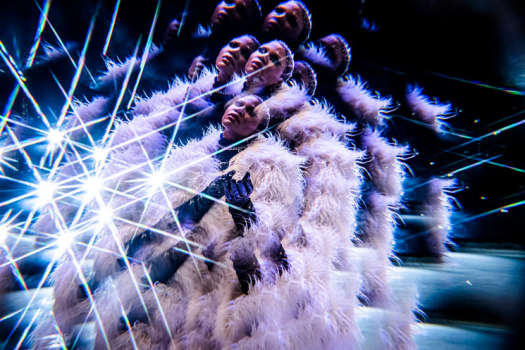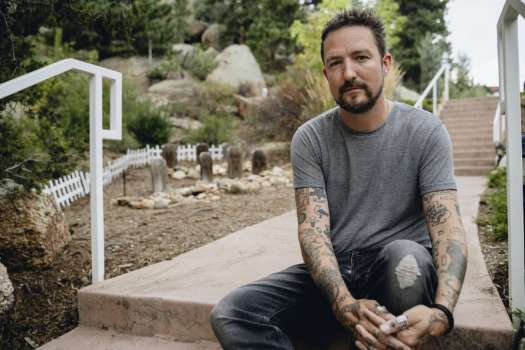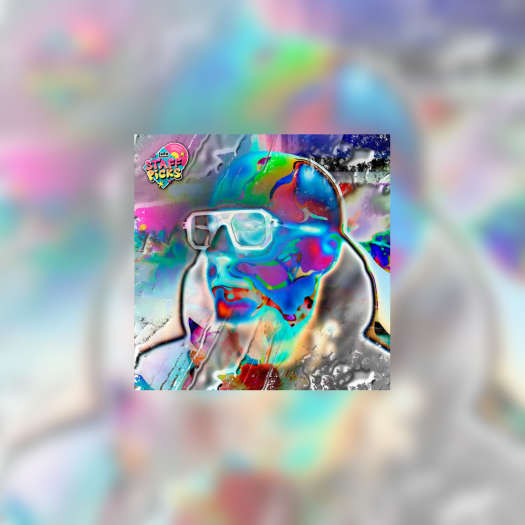A foot-long poodle is licking your shins. You are in the foyer of Michel Rabagliati's suburban home a tan, well-kept, sensible abode. "Stop it, Biscuit," the cartoonist calls as he swats the pet away, but it follows you, tongue-to-limb, past the kitchen and down the stairs to the immaculate basement studio. The atelier is cosy and bright, beyond clean. A toy kitchen range squeezed to one wall next to a photocopier, a wall-length cork board tacked with posters and sketches all manner of cartoonage above expensive-looking computer equipment, a polished light table and an ergonomic office chair. "Maybe I'm not enough of an artist," Rabagliati shrugs. "I like a little security in my life; to have some money to go on vacation."
The money is a holdover from his previous employment: first as a graphic designer his cereal boxes and diaper packaging may still be found in Quebecois supermarkets then an illustrator, one of the first computer artists in Montreal, whose blocky, layered collages of gingery people enjoying themselves spread cheer throughout the pages of Today's Parent and The Chicago Tribune, among many titles. "It was really kind stuff," he says of the artwork, flipping through a lush portfolio. "No one called me to draw a suicide or rape." He had an agent who kept him feverishly busy, a live-in girlfriend, a young daughter.
At age 41, Michel Rabagliati bounces like a schoolboy on a sugar high, his hands stifling a giggle, as he describes the "bell" that rung when he discovered, in the midst of his success, the world of alternative comics to which he would soon defect. A chance encounter with an old friend had led him to the ring of modern cartoonists reinventing the medium Seth, Joe Matt and others in North America; Blutch, Dupuy & Berberien et al in Europe. Rabagliati had found his ilk, and passion.
"It's a good time for these types of comic books," he says. "This generation is ready to read serious stories, in black and white. You couldn't have done something like this 15 years ago."
Paul in the Country, his first comic book, was self-published in its original French four years ago, and translated, reprinted and distributed worldwide by Drawn & Quarterly just months later. With the bare brushwork of early American cartoon shows (the gumby-limbed Jetsons and Gerald McBoing Boing), it chronicles his Montreal childhood, relived on a visit to his parents in the countryside. "I'm too lazy," he says repeatedly of his drawings, though their casual precision suggests otherwise. "The story, I work on very hard, but the drawings I let go. For me, they're not that important." The plot, he likes concise. "My pace is fast, it's beyond my control. I'm glad when the machinery is working."
It certainly worked for readers, like the critics who named him Best New Talent at the 2001 Harvey Awards (the industry's Oscars), and those who bestowed the same title on him in Quebec a year earlier. He admits shyly, "If people didn't like the first [one], I would have probably given up."
Two short stories followed, then his first graphic novel, Paul a un travail d'été, about his summer as a camp counselor for les enfants défavorisés. The English translation (Paul Has a Summer Job) made its debut at the Toronto Comic Arts Festival in March.
Paul is his stand-in, sweetly naïve and constantly teased for his massive eyebrows (shared by the artist, who bears a passing resemblance to Roots co-founder Michael Budman). "I like to tell real stories to bathe in my memories. But I want to keep a distance," he says of the made-up bits that round out the plot. "I'm always afraid that family and friends could come back and complain if a character does nasty stuff. I want to be free to write the stories I want." His thinly veiled confessions/autobiographies are vivid and reflective, suffused with an air of gentleness. They're also very funny without being cynical or lurid, and try to give readers "echoes from another country."
"I want the reader to take a trip," he says, "I want to point out little things that are Quebecois and charming and poetic, the different undulations of accents, the expressions and imagination. I don't know if Quebecois culture is going to survive; I want it to be printed somewhere." He keeps photography books of old Montreal street scenes, for inspiration, and with his own camera has filled an album with shots of the city's streets and houses, all of which finds its way into his panels. "The city is transforming itself. It's becoming trendy, with specialised boutiques. Mont Royal Avenue is now devoted to the jet set. I'm nostalgic."
The diaper boxes are well behind him. "I'm at a period of my life where it's important to do my projects now, while I have the chance."
The money is a holdover from his previous employment: first as a graphic designer his cereal boxes and diaper packaging may still be found in Quebecois supermarkets then an illustrator, one of the first computer artists in Montreal, whose blocky, layered collages of gingery people enjoying themselves spread cheer throughout the pages of Today's Parent and The Chicago Tribune, among many titles. "It was really kind stuff," he says of the artwork, flipping through a lush portfolio. "No one called me to draw a suicide or rape." He had an agent who kept him feverishly busy, a live-in girlfriend, a young daughter.
At age 41, Michel Rabagliati bounces like a schoolboy on a sugar high, his hands stifling a giggle, as he describes the "bell" that rung when he discovered, in the midst of his success, the world of alternative comics to which he would soon defect. A chance encounter with an old friend had led him to the ring of modern cartoonists reinventing the medium Seth, Joe Matt and others in North America; Blutch, Dupuy & Berberien et al in Europe. Rabagliati had found his ilk, and passion.
"It's a good time for these types of comic books," he says. "This generation is ready to read serious stories, in black and white. You couldn't have done something like this 15 years ago."
Paul in the Country, his first comic book, was self-published in its original French four years ago, and translated, reprinted and distributed worldwide by Drawn & Quarterly just months later. With the bare brushwork of early American cartoon shows (the gumby-limbed Jetsons and Gerald McBoing Boing), it chronicles his Montreal childhood, relived on a visit to his parents in the countryside. "I'm too lazy," he says repeatedly of his drawings, though their casual precision suggests otherwise. "The story, I work on very hard, but the drawings I let go. For me, they're not that important." The plot, he likes concise. "My pace is fast, it's beyond my control. I'm glad when the machinery is working."
It certainly worked for readers, like the critics who named him Best New Talent at the 2001 Harvey Awards (the industry's Oscars), and those who bestowed the same title on him in Quebec a year earlier. He admits shyly, "If people didn't like the first [one], I would have probably given up."
Two short stories followed, then his first graphic novel, Paul a un travail d'été, about his summer as a camp counselor for les enfants défavorisés. The English translation (Paul Has a Summer Job) made its debut at the Toronto Comic Arts Festival in March.
Paul is his stand-in, sweetly naïve and constantly teased for his massive eyebrows (shared by the artist, who bears a passing resemblance to Roots co-founder Michael Budman). "I like to tell real stories to bathe in my memories. But I want to keep a distance," he says of the made-up bits that round out the plot. "I'm always afraid that family and friends could come back and complain if a character does nasty stuff. I want to be free to write the stories I want." His thinly veiled confessions/autobiographies are vivid and reflective, suffused with an air of gentleness. They're also very funny without being cynical or lurid, and try to give readers "echoes from another country."
"I want the reader to take a trip," he says, "I want to point out little things that are Quebecois and charming and poetic, the different undulations of accents, the expressions and imagination. I don't know if Quebecois culture is going to survive; I want it to be printed somewhere." He keeps photography books of old Montreal street scenes, for inspiration, and with his own camera has filled an album with shots of the city's streets and houses, all of which finds its way into his panels. "The city is transforming itself. It's becoming trendy, with specialised boutiques. Mont Royal Avenue is now devoted to the jet set. I'm nostalgic."
The diaper boxes are well behind him. "I'm at a period of my life where it's important to do my projects now, while I have the chance."




